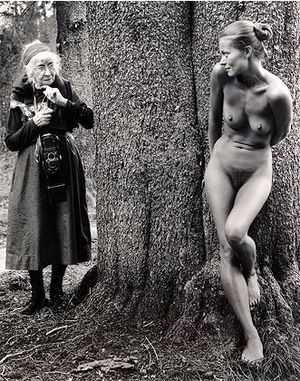Imogen and Twinka at Yosemite
 Imogen and Twinka at Yosemite | |
| Artist | Judy Dater |
|---|---|
| Year | 1974 |
| Type | photograph |
| Subject | portrait, nude |
Imogen and Twinka at Yosemite is a 1974 photograph by Judy Dater. It depicts elderly photographer Imogen Cunningham, encountering nude model Twinka Thiebaud behind a tree in Yosemite National Park. It is considered Dater's "most popular" photograph and according to the photographer, was inspired by Thomas Hart Benton's painting Persephone, which portrays a voyeur observing a nude woman reclining against a tree, who had been bathing in a stream.[1]
Background
Dater had been familiar with Benton's 1938 Persephone painting and its theme of voyeurism since her childhood, and it inspired her to attempt several earlier photos based on that theme. She has said that it "really worked" with this particular photo, because "it's a twist, given that it's two women looking at each other."[2]
At the time the photograph was taken, Cunningham was 90 years old and had been a famous photographer for 60 years. Dater had been a friend and admirer for the previous ten years, and considered Cunningham her mentor. The nude model, Twinka Thiebaud, was the daughter of painter Wayne Thiebaud. Dater had earlier photographed Twinka fully clothed, in 1970. [3]
The photograph was taken as part of a workshop called "The Nude in the Landscape", organized by Ansel Adams, that had about 100 students. Dater was one of the instructors, and Cunningham was a guest lecturer.[2] According to Twinka Thiebaud, the event started out in an undisciplined way. The clueless students swarmed around the nude models, and they "pounced like paparazzi", and were "unruly and disorganized".[2] Dater, Cunningham and Thiebaud stepped away from the crowd, and approached the tree. There, as many of the students gathered around her, Dater demonstrated how to work with a model. This photograph was the result.[2]
Critical reaction
The photo was immediately the subject of feminist critical analysis. In 1974, critic Lucy Dougan wrote that the photo "parodies depictions of male voyeurism in the history of Western art, as it playfully amends all those mythical violations of sacred places. It juxtaposes the city against the pastorale: Cunningham's technological baggage of city life/city seeing hangs around her neck in the form of a large camera, but here it is obsolete and new ways of seeing and old narratives come together."[4] She went on to compare the photo to a poem by Kathleen Raine that talks about an old woman's memory of her young breasts, but concludes that the photo has a "much lighter tone of heart" than the poem.[4]
In 1997, critic Sarah Boxer described the photo as "Imogen Cunningham sneaking around the trunk of a giant tree in Yosemite National Park and coming upon Twinka, a nude model who has one leg propped on a root and is looking around coyly" and called it "an amusing play" on the goddess Diana.[5] In 1999, critic Margarett Loke said that the photo "remains a delightful send-up of a photographer with a nude subject".[6] In 2011, critic Donna Stein wrote that "Dater reverses the traditional erotic relationship of a leering old man eyeing a voluptuous nude to show two women - youth and old age - confronting each other." [7] Stein reports that the photo "pays homage to the Persephone myth as portrayed in a painting by Thomas Hart Benton".[7]
Legacy
John Hildebidle, poet and literature professor at the Massachusetts Institute of Technology,[8] has written a poem inspired by the photograph.[9] A print of the photo is in the collection of the Los Angeles County Museum of Art.[10] The photo was part of an exhibition on the art of Yosemite which appeared at the Autry National Center, the Oakland Museum of California, the Nevada Museum of Art and the Eiteljorg Museum of American Indians and Western Art from 2006 to 2008.[11]
References
- ↑ Zakia, Richard D. (2013). Perception and Imaging: Photography--A Way of Seeing. London: Taylor & Francis. pp. 319–322. ISBN 9780240824536.
- ↑ 2.0 2.1 2.2 2.3 Sykes, Claire (Fall 2012). "Judy Dater: Seeing and Being Seen". Photographer's Forum (Santa Barbara, California: Serbin Communications). pp. 10–20. Retrieved April 5, 2014.
- ↑ Coleman, A.D. (January 13, 1974). "Photography: Do Men Have It Any Easier?". New York Times. Retrieved April 6, 2014.
- ↑ 4.0 4.1 Dougan, Lucy; edited by Hilary Fraser and R. S. White (1994), "Women's Bodies and Metamorphosis", Constructing Gender: Feminism and Literary Studies, Perth: UWA Publishing, p. 14, ISBN 9781875560349
- ↑ Boxer, Sarah (September 19, 1997). "PHOTOGRAPHY REVIEW; Beauty, in a Variety of Guises". New York Times. Retrieved April 6, 2014.
- ↑ Loke, Margarett (June 25, 1999). "PHOTOGRAPHY REVIEW; Celebrating a Departure, With a Bow to the Body". New York Times. Retrieved April 6, 2014.
- ↑ 7.0 7.1 Stein, Donna; edited by Joan M. Marter, "Judy Dater", The Grove Encyclopedia of American Art 1, Oxford University Press, pp. 22–23, ISBN 9780195335798
- ↑ "Faculty: John Hildebidle". LIT@MIT. Massachusetts Institute of Technology. 2011. Retrieved April 6, 2014.
- ↑ Hildebidle, John (1999). Defining Absence. Cliffs of Moher, Republic of Ireland: Salmon Publishing. p. 31.
- ↑ "Imogen Cunningham and Twinka, Yosemite". Los Angeles County Museum of Art. Retrieved April 6, 2014.
- ↑ Scott, Amy (2006). Yosemite: Art of an American Icon. Los Angeles and Berkeley: Autry National Center and University of California Press. p. 138. ISBN 9780520249226.